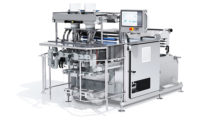Consumer demand for convenience packaging and product freshness are driving the design and manufacture of bagging and closing equipment in the snack food and wholesale bakery market. The latest machines feature higher production speeds, smaller footprints, sanitary designs and smart technology.
The desire by consumers for convenience packaging in all market segments continues to grow, and this convenience is often realized via flexible packaging. This demand continues to fuel the need for machines that can fill flexible packaging, and then seal the primary packaging for freshness.
Shoppers want to see the product they are purchasing and want to maintain product freshness in a recloseable package, according to Tom Egan, vice president of industry services, PMMI, Reston, VA. “This requires secondary packaging equipment that can provide gentle package handling while orienting bagged product for easy display in the retail environment.”
Consumers are demanding more choices in terms of package size, which boosts the number of SKUs hitting stores. In multi-use sizes, resealable or reclosable packaging tops the list of desirable features, says Erin Henry, senior marketing manager, Zip Pak, an ITW Co., Manteno, IL. “Food processors are reacting by looking for equipment that is able to produce a wider range of package formats and sizes, with increased changeover speeds and the ability to add reclose.”
As snack and bakery companies aim to maximize brand shelf appeal, the demand for stand-up pouches continues to grow. “The accessibility and wide opening of the Doy bag provides ease-of-use, while the reclosable zipper keeps product fresh,” says Kelly Meer, product manager, Bosch Packaging Technology Inc., New Richmond, WI.
Technology trends
Food products today are developed, manufactured and introduced to the retail market more quickly than ever before. Thus, it is important that equipment manufacturers deliver high-performance systems with smaller footprints that package the same amount of product in more bags. Vertical form/fill/seal (VFFS) systems that are capable of speeds above 200 bags per minute offer significant advantages in terms of ambitious throughput targets and high productivity.
“But it’s not enough to just aim for high bagging speeds,” says Alf Taylor, CEO, TNA North America, Coppell, TX. “It’s also important to equip machines with smart technology that can deliver a high level of effectiveness that is capable of continuous improvement. A low reject rate; high level of flexibility; ease of maintenance, operation and integration; and a low environmental footprint are all part of this trend.”
The tna robag 5 is a VFFS that operates at speeds up to 300 bags per minute. Suitable for bagging a variety of snacks, the machine incorporates a tna intelli-weigh 0220 omega scale, which is capable of combining different products, while offering fast and accurate product transfer with minimum waste.
“In addition, the integration of ultrasonic back-seal technology allows us to overcome the thermal transfer limitations of traditional heat-seal methods and provide superior seal integrity even at high speeds,” Taylor says. The tna robag 5 also features a CXE controller that reduces maintenance costs and downtime by supplying users with instant, detailed system diagnostics.
Today’s production environment also requires bagging and closing equipment that offers maximum flexibility within a small footprint. The ability to run multiple pack styles on a single VFFS is gaining importance.
Hygiene and food safety is another priority. “Strict food safety regulations, combined with consumers’ increasing awareness of product impurities and allergens, and the FDA’s 2011 Food Safety Modernization legislation has resulted in the focus shifting from outbreak response to prevention. This is commonly reflected in production and processing areas,” Meer says.
“We also see a growing need for complete system solutions that integrate primary and secondary equipment, thus allowing bakery/snack producers to streamline production, reduce downtime and facilitate training,” says Meer. A good example, he notes, is the Bosch SVE 3220 DZ, which is integrated with the CCM 3100 case packer. This packaging solution features a wide format range in both bag and case sizes, as well as case styles, including regular slotted container (RSC), half slotted container (HSC) and other shelf-ready packaging styles.
Burford Corp., Maysville, OK, designs versatility into its packaging machines, which are capable of working with several different types of baggers. Food processors can use the same machine on their bread or bun line, thus saving money. The company recently upgraded its Twist Tyer machines, which enables them to run at higher package rates. “We’ve designed a belt system that can be added to either the model 2000M Servo or model 2200M Smart Servo to help control the bag tail earlier, making it easier to run at higher conveyor speeds,” says Mitch Lindsey, technical sales manager.
Ongoing innovations
Kwik Lok Corp., Yakima, WA, has released a new version of its model 893B automatic bag closer, which is manufactured in metric measurements and stainless steel, according to Bruce Cox, regional sales director. Featuring closing head speeds of up to 120 packages per minute, it incorporates stepper motors, PLC controls and a touchscreen. “We’ve also introduced the 088 horizontal bag closer, which gives small bakeries the ability to close bags automatically at speeds up to 35 packages per minute.”
Zip-Pak has introduced the 360 tdi Series, a compact transverse zipper applicator for VFFS and bag conversion machines. The compact applicator is capable of running narrow or wide flange zippers, and allows for faster operation and accurate registration.
The LX8 Inline Bagging System from LeMatic Inc., Jackson, MI, features auto-adjust product guides (and height transition for stacking) that set themselves automatically based on product selection. Auto-adjust height transition accommodates up to 3-inch-high products and optimizes product stacking and packaging. “Modular design and plug-and-play modules make for easy installation and flexibility,” says Brandon Woods, director of sales.
All Packaging Machinery Corp., Ronkonkoma, NY, offers a horizontal rotary-band sealing system with a bag top trimmer. It is designed to seal bags for a wide range of bakery products such as flour or corn tortillas, pita breads, panini and flatbreads. An optional overhead assembly compresses product and removes excess air for case packaging of final product—no compressed air required.
Multivac Inc., Kansas City, MO, has introduced a wide range of thermoforming machines that pack baked goods in heat-sealable flexible and semi-rigid materials under vacuum and modified atmosphere. This protects and preserves products such as naan bread, gluten-free baked goods, sliced breads, par-baked baguettes, pretzels, breakfast sandwiches and frozen pizzas.
Meeting challenges
Demand for frequent changeover is one challenge that manufacturers face when designing bagging and closing equipment for snack and bakery plants. This is driving innovation of modular and flexible machines. “Also, all production operations must soon meet FSMA regulations. While the timing is staggered based on the size of the business, the regulations require more ingredient and product tracking, plus increased production equipment checks for clean operation,” Egan says.
Temperature control is another challenge. “Creating a zipper that can handle the transition from a warm environment to a frozen environment requires expertise in material application for both the zipper and film to which is attached,” Henry says.
Production and packing of baked goods generally occur in a warm environment. The electronics that are used to run packaging equipment also generate heat inside the cabinet. “When designing our equipment, we take steps to ensure the electronics cabinet is kept at a safe operating temperature,” says Cem Yildirim, market development sales manager, Multivac Inc.
Looking ahead, the increasing efficiency and sophistication of stepper and servo motors, and programmable logic controllers (PLCs), will help bagging and closing machines attain even higher line speeds. “Perhaps more importantly will be the integration of the Internet of Things (IoT) into the production environment. For example, if your equipment notifies you of an impending component failure and you can avoid unscheduled downtime, that feature is more important than increasing the number of bags per minute,” Cox notes.
In recent years, the food processing industry has started to move toward Industry 4.0 and complete systems, and will most likely continue down this path, according to Meer. “As a gateway to Industry 4.0, Bosch’s new cookie and cracker packaging systems are equipped with human-machine interface 4.0 touchscreens that guide the operator through each step of the production process. The clearly structured menus give them an overview of machine status and provide step-by-step instructions for everyday operations using pictures and videos.”












